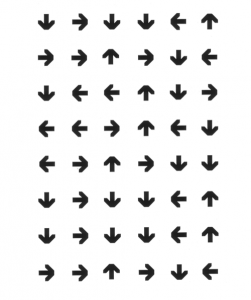Kirshner Arrows
Purpose: To aid in the development of ocular motility, left to right scanning/progression, laterality, directionality, visual-auditory integration, visual motor integration, and speed of recognition.
Equipment/Apparatus: Kirshner arrows worksheets, metronome.
Method:
1. Say to the child “Hold your hands out in front of you and place them together palm to palm, like you are going to dive into water. I’m going to show you pictures of arrows and you must point your hands in the direction of the arrows. When I say ‘go’, you start at the upper left corner (point it out) of the page and go across each line from left to right, then move from the top line to the next line down, etc. Each time you point your hands in the direction of the arrow, you must say ‘up’, ‘down’, ‘left’, or ‘right’.”
2. Try loading the activity with the metronome as indicated in ‘Loading’ item 1 below. Also consider rotating the sheet to change the sequencing.
Loading:
1. Once the child can fairly readily do the activity above with no prompting, repeat the activity with the metronome. Start at a pace that is similar to what was done without the metronome (or 45-50 bpm), then build up speed by 10 bpm until the child can handle 100 bpm or so. This can be quite challenging and not all children will be able to keep up with this pace initially. You may need to revisit this exercise a few times over a few months to get the speed up.
2. Have the child do the exercise as described in ‘Method’ but have them say the number of fingers held up in each picture. Once this can be easily done at a slower pace, pick up the pace with the metronome as described in 1. above.
At the end of the session (do this for perhaps 10 minutes or so), have the child determine what his goals will be for the next session. Record the results.






